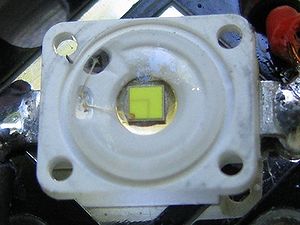Osram: Difference between revisions
(a little more about the differences between GD and GDP) |
(more description of banding after I graphed some values) |
||
| Line 19: | Line 19: | ||
|} | |} | ||
There are tint families for warm white (product code LCW, also includes neutral white tints), white (LW), and ultra white (LUW, others call it cool white). The warm white and ultra white families sometimes seem to follow [[ANSI White]] with each ANSI White quadrangle | There are tint families for warm white (product code LCW, also includes neutral white tints), white (LW), and ultra white (LUW, others call it cool white). The warm white and ultra white families sometimes seem to follow [[ANSI White]] with a number of subgrids overlaid on each ANSI White quadrangle and sometimes falling above or below the ANSI quadrangle. It doesn't seem to be their intention to bin by individual subgrid but by groups of subgrids. The grid has numbers which are vertical subdivisions (6500K is divided into layers 4, 5, 6, 7, and 8 with 4 falling below and 8 falling above ANSI 6500K) and letters which are horizontal (they follow the color temperatures; for instance, 6500K is divided into vertical bands C,D, and E while 5700K is divided into F and G, and no bands are cooler than ANSI 6500K) as follows: | ||
{|class="wikitable" style="text-align: center; width: 400px;" | {|class="wikitable" style="text-align: center; width: 400px;" | ||
| Line 40: | Line 40: | ||
|4U-9X || 24 || 2700K || warm white | |4U-9X || 24 || 2700K || warm white | ||
|} | |} | ||
To make it a little more confusing, Osram has a different set of chromaticity groups that are not based on ANSI white but whose codes look very similar. These also appear in their datasheets. The regular white products only use this nonstandard approach. | |||
Revision as of 18:22, 4 September 2011

Osram is a German company owned by Siemens. Their subsidiary that produces LED's is called Osram Opto Semiconductors GmbH. Osram is known for the Golden Dragon series of LED's and the OSTAR multiple-die LED's. The Golden Dragon Plus LED (comparable to a Cree XP-E) was used in several NiteCore flashlight models and is still used in some budget models. The Golden Dragon Plus is denoted by the product code W5AM while the regular Golden Dragon is W5SM. The difference between the two seems to be the Plus has a clear silicone lens over the LED while the Golden Dragon has flatter clear resin. However for some reason, the GDP seems to have a wider hotspot which is opposite of what a lens should do. In the corner of the LED is a very small red diode that lights when the polarity is reversed (if it is not covered by the reflector; this probably wouldn't work with most lights because the driver won't allow reverse polarity).
| Bin | 350mA 100% |
700mA 170% |
1000mA 220% |
|---|---|---|---|
| JZ | 61-71 | 104-121 | 134-156 |
| KX | 71-82 | 121-139 | 156-180 |
| KY | 82-97 | 139-165 | 180-213 |
| KZ | 97-112 | 165-190 | 213-246 |
| LX | 112-130 | 190-221 | 246-286 |
| LY* | 130-150 | 221-255 | 286-330 |
There are tint families for warm white (product code LCW, also includes neutral white tints), white (LW), and ultra white (LUW, others call it cool white). The warm white and ultra white families sometimes seem to follow ANSI White with a number of subgrids overlaid on each ANSI White quadrangle and sometimes falling above or below the ANSI quadrangle. It doesn't seem to be their intention to bin by individual subgrid but by groups of subgrids. The grid has numbers which are vertical subdivisions (6500K is divided into layers 4, 5, 6, 7, and 8 with 4 falling below and 8 falling above ANSI 6500K) and letters which are horizontal (they follow the color temperatures; for instance, 6500K is divided into vertical bands C,D, and E while 5700K is divided into F and G, and no bands are cooler than ANSI 6500K) as follows:
| Bins | Subgrids | Temperature | Family |
|---|---|---|---|
| 4C-8E | 15 | 6500K | ultra white |
| 5F-8G | 8 | 5700K | ultra white |
| 4J-8K | 10 | 4500K | warm white |
| 4L-8N | 15 | 4000K | warm white |
| 4O-9Q | 18 | 3500K | warm white |
| 4R-9T | 18 | 3000K | warm white |
| 4U-9X | 24 | 2700K | warm white |
To make it a little more confusing, Osram has a different set of chromaticity groups that are not based on ANSI white but whose codes look very similar. These also appear in their datasheets. The regular white products only use this nonstandard approach.